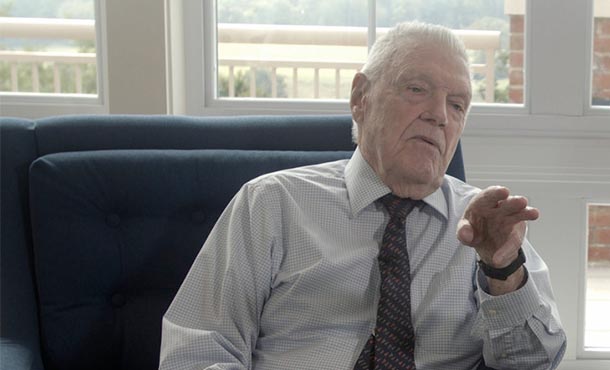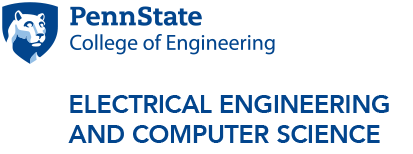
Garrett “Mitch” Mitchell, age 97, piloted C-54 Skymaster transport planes during World War II, logging 69 missions from India to China and back. IMAGE: KALEB COOK, PENN STATE OFFICE OF STRATEGIC COMMUNICATIONS
World War II pilot discusses his 69 missions flying C-54s over 'The Hump'
10/31/2019
By Chris Koleno
This is the first of a three-part series profiling World War II veterans who graduated from Penn State.
According to the U.S. Department of Veterans Affairs, approximately 16 million Americans served during World War II. Of those who served, it is estimated that less than 5%, or roughly 400,000 veterans, are still alive — most all in their 90s or older.
One member of this era, often referred to as the “Greatest Generation,” is Penn State alumnus Garrett “Mitch” Mitchell, age 97, who piloted C-54 Skymaster transport planes during World War II, logging 69 missions from India to China and back. Returning to Pennsylvania after being discharged, he earned his degree at the University.
Mitchell began his military career by enlisting in September 1942, after graduating from Dickinson Junior College in Williamsport, Pennsylvania. After enlisting, Mitchell continued his education at Penn State for two semesters before being called up to active duty.
“When I was called up there were 204 students (April 1943) called at the same time. They brought a train, backed it up from Bellefonte, right to College Avenue,” said Mitchell.
After training to be a pilot, Mitchell was sent to India from Miami on New Year’s Eve in 1944. He quickly put that training into action, flying C-54 planes as part of the Army Air Force’s Air Transport Command over what was referred to as “The Hump,” the nickname given to the eastern end of the Himalayan Mountains between India and China to resupply units during the Chinese war effort against Japanese forces in Burma.
“It was really quite a problem for them to get the gas, so we carried 50, 55 gallon drums in the plane and we would carry that and then they would drain our wing tanks, leaving us enough gas to get home,” he said.
While Mitchell did not see any enemy action during these flights, these missions were far from a safe assignment.
“The big thing there was weather and mechanical problems,” he said. “We lost about 800 planes in that operation and there were three people on board (each plane), so that’s about 2,400.”
Many of these planes and the veterans on board were never seen again.
“You have to picture that land, you know is jungle,” said Mitchell. “It’s not like flying say over Europe where the casualties there were found because there are farms or cities or whatever. Over there it was jungle, so if a plane went down in that, it may or may not be found. I think the last I heard there were around 230 individuals who had not been recovered.”
Mitchell counts his blessings that he was able to return after each of his 69 missions.
“And 69 times back, happily,” he said.
Mitchell was discharged in early 1946 and marred his then-girlfriend Laura that same year. Laura Mitchell served at Richmond Army Hospital in Virginia as a registered nurse and was humble about her military experience, nursing amputees back to health.
“We had casualties, but nothing serious came into our hospitals,” Laura Mitchell said. “The really serious cases were kept in the military hospitals.”
After the war Garrett Mitchell left the service and returned to Penn State under the GI Bill to continue his studies, living with an electrical engineering professor named Gilbert L. “Pop” Crossley.
“I wanted to be an engineer and they (Penn State) have a great engineering school,” said Garrett Mitchell.
In 1948, Garrett Mitchell graduated from Penn State with a bachelor of science degree in electrical engineering.
After graduation, Garrett and Laura Mitchell settled in the Lock Haven, Pennsylvania, area, where he worked for more than 37 years for New York & Pennsylvania Co., which merged into Hammermill Paper Co., retiring as manager of manufacturing services.
While in Lock Haven, the couple attended many Penn State football games.
“Fifty-five minutes from our door to campus,” Garrett Mitchell said.
Garrett and Laura Mitchell reside in The Village at Penn State and in past years have rekindled their connection with the University by attending women’s basketball and women’s soccer games.
The couple’s son, David Mitchell, now retired; their daughter-in-law Lisa Mitchell; and two of their three grandchildren also have graduated from Penn State, perpetuating the family’s link to the University for generations to come.
Two more stories featuring Penn State alumni who served during World War II — Leon Kneebone and Alexander “Lew” Parry Jr. — will be published in the upcoming weeks. A video featuring all of these veterans is also available.
Penn State has a longstanding and proud tradition of serving the men and women of our military through education benefits, resources, support and more. This year’s Military Appreciation Week from Nov. 8 to 16 will honor America’s “Greatest Generation” with a weeklong series of campus events, including a football game, Veterans Day ceremony, speaker series and more. Visit militaryappreciation.psu.edu to learn more.



